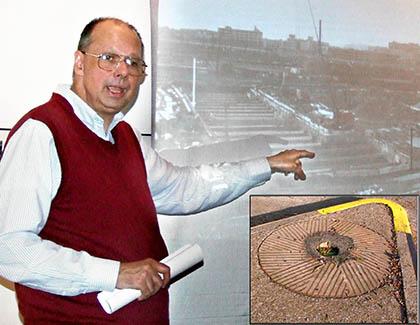By Nathan Duke
A trio of western Queens civics are fighting to preserve a pair of Long Island City millstones from the 17th century, but the groups are not necessarily in agreement on where to store the artifacts.
The millstones were constructed by the Dutch more than 450 years ago as part of a large tile mill in Long Island City. The two stones, believed to be the oldest surviving European artifact in Queens, are currently being held at a construction site within the massive Queens Plaza redevelopment project.
“They’ve been in Dutch Kills for hundreds of years,” said Barbara Lorinz, president of the Dutch Kills Advocacy League. “We’d like to keep them safe and secure. They don’t need to be on a construction site. They need to be in a safe place.”
The Greater Astoria Historical Society has proposed housing the stones at their site on Broadway in Astoria, while the Dutch Kills Civic Association wants to keep the artifacts in Long Island City.
Another idea that has been floated is to hold the stones at the Queens Library’s branch on 21st Street in Long Island City.
The stones, which are four six to feet wide in diameter and weigh at least 400 pounds, were used as part of the tile mill’s operation to grind wheat into flour. But the mill was closed down in the 1820s and its site was then owned by a family farm before Queens Plaza was created in 1909.
The contractor in charge of the plaza’s redevelopment currently has plywood sheets covering one of the stones, which is still embedded in the ground and slightly cracked, and is storing the other stone in a truck at the construction site. The cracked stone is also surrounded by barricades.
The Queens Plaza project includes street repaving and the creation of a new common area.
Robert Singleton, president of the Greater Astoria Historical Society, said his group has proposed displaying the stones at its museum.
“The stones have experienced substantial deterioration,” he said. “We have photos of them from years ago and you can see the difference. In a place like Queens Plaza, they are exposed to the elements and vibrations from traffic. We’d like them to be in a place that’s safe and open to the public, where they can be on display and available for research.”
But Gerald Walsh, president of the Dutch Kills Civic Association, said his group wants the stones to remain in Dutch Kills and eventually incorporated into the new park at Queens Plaza.
“We want holes to be drilled in the stones in order to move them,” he said. “And we want the stones kept at Queens Plaza and not to wind up in some museum.”
He said the civic has suggested mounting the artifacts at an angle and identifying them with a plaque.
On Monday, Borough President Helen Marshall met with the city Economic Development Corp., which is in charge of the Queens Plaza redevelopment, and discussed the stones.
“The borough president said she wanted the millstones preserved and protected, but she has not yet decided which option she prefers,” said Dan Andrews, a spokesman for Marshall. “It could certainly be a historical society or another venue, but it hasn’t reached that stage yet.”
The EDC has hired a preservation consultant to keep an eye on the stones during the construction.
Reach reporter Nathan Duke by e-mail at nduke@cnglocal.com or by phone at 718-260-4566.



































